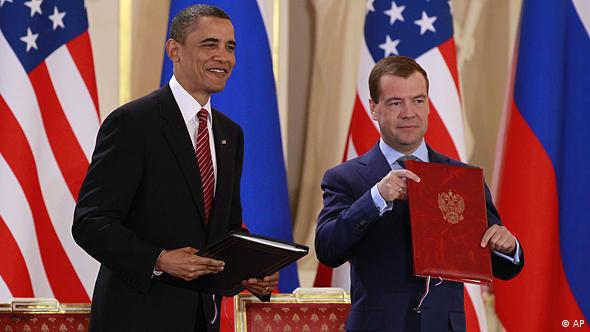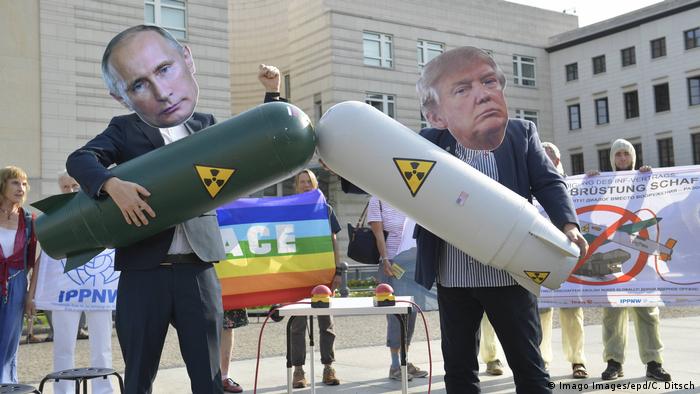
Russia has issued a double message: the US will not be allowed to inspect Russia’s nuclear arsenals for the time being. But Moscow would abide by the terms of the treaty and is fully aware of “its unique role” as an “important instrument for maintaining international security and stability,” the Russian foreign ministry said. However, the unprecedented step to suspend inspections shows the shadow the war in Ukraine has cast over relations between the two countries.
According to Deputy Foreign Minister Sergei Ryabkov, his county’s action was triggered by Washington’s notification to carry out an inspection on Russian territory in the coming days. Given the current tensions in bilateral relations, this indeed seemed like a “direct provocation,” Ryabkov stressed.
It is important to know that inspections have been suspended since the beginning of 2020 not because of geopolitical considerations but because of the COVID-19 pandemic.
When Presidents Barack Obama (l) and Dmitry Medvedev signed New START in 2010, tensions were lower than they are today.
Russia sees a “one-sided advantage” for the US
START stands for Strategic Arms Reduction Treaty. The 2010 agreement obliges both sides to limit their deployed strategic warheads to 1,550, and limits delivery systems such as ICBMs, submarines and bombers to 800 per side. This agreement also included each party agreeing to allow up to 20 inspections each year on the other’s territory.
The current situation provides the US with “unilateral advantages” as it effectively “deprives the Russian Federation of the right to carry out inspections on American territory,” Moscow’s foreign ministry said in a statement.
This is where the war in Ukraine comes into play, if only indirectly. The war itself, in which Russia is the aggressor and the US supports Ukraine in many ways, is not the reason given by Russia for stopping the work of the inspectors. Moscow only points to the fact that due to Western sanctions, Russian inspectors have trouble entering the US. In addition, Russian representatives in the US face health risks due to the increasing number of COVID infections. Once the current issues are resolved, Russia would allow inspections again, “immediately.”
In Germany, protesters took to the streets in 2019 when the US withdrew from the INF treaty
US withdraws from important treaties
The New START agreement was the latest in a long list of disarmament efforts between the major nuclear powers. In the 1990s there were the two START treaties. But START-I expired in 2009 and START-II never entered into force. The result of which was the follow-up agreement New START.
In the 1970s, the US and the Soviet Union had signed disarmament treaties such as the 1972 ABM agreement that limited missile defense systems. But the Americans unilaterally withdrew from this agreement in 2002. And in 2019, under President Donald Trump, Washington withdrew from the INF treaty on land-launched intermediate-range missiles, and in 2020 Trump announced that the US was abandoning aerial surveillance of the open skies. treaty, which had been seen as a measure of confidence. What remained was the New START agreement.
![]()
Biden wants China in the picture
But now the future of this agreement is also being questioned. Just last year it was extended for a maximum period of five years and is scheduled to expire in 2026. And the Russian side says it must stay that way, regardless of war or sanctions.
But what will happen after 2026? Russian Foreign Minister Sergei Lavrov recently complained that Washington had not made any offers for new negotiations. For his part, US President Joseph Biden said in January that his administration was ready for talks on a follow-up agreement. But, he added, Russia’s war against Ukraine amounts to an attack on the very pillars of the international order. Biden also called on China to join efforts to follow through on New START.
China’s nuclear arsenal is significantly smaller than that of the US. Stockholm-based peace research institute SIPRI estimates in its 2022 report that China’s nuclear warheads number is 350. But, it adds, China is catching up fast . And with Western concerns over the possibility of a Chinese takeover of Taiwan, it’s no surprise that Biden would like to see China at the negotiating table. But Beijing and Moscow have argued in the past that French and British nuclear arsenals, totaling up to 500 warheads, should also be on the agenda.
![]()
In 1985, Moscow paraded Soviet SS-21 missiles in Red Square on Victory Day.
Nuclear deployment is more likely than ever
During the Cold War of the 1980s, the global total of nuclear warheads stood at 70,000. SIPRI’s current figure is just under 13,000. But this drop in numbers offers little consolation because of the technical modernization of today’s weapons compared to the great mass of previous decades. Today’s nuclear weapons are simply much more accurate. And the development of so-called “mini-nukes,” which may not be able to destroy an entire country but instead provide a tactical advantage, makes nuclear deployment even more likely.
SIPRI’s latest annual report spoke of “clear indications” as early as 2022 that the reduction in the global nuclear arsenal seen after the end of the Cold War “has come to an end”. Also: “All nuclear powers are currently doing what they can to further boost or modernize their arsenals. Most of these countries are also stepping up the tone of their rhetoric, putting their nuclear potential at the center of their strategies military. Something very worrying. trend.”
That report came just weeks before Russia’s February 24 invasion of Ukraine. And since then Moscow has made it very clear that it does not rule out the use of nuclear weapons.
This article was originally written in German.
While you’re here: Every Tuesday, DW editors round up what’s happening in German politics and society. You can sign up for the weekly Berlin Briefing newsletter here.
[ad_2]
Source link






